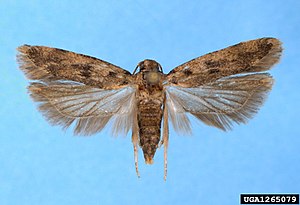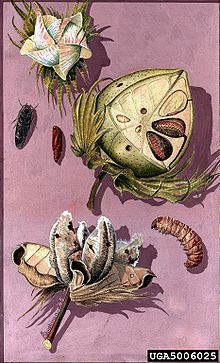Red cotton bollworm
| Red cotton bollworm | ||||||||||||
|---|---|---|---|---|---|---|---|---|---|---|---|---|

Red cotton bollworm ( Pectinophora gossypiella ) |
||||||||||||
| Systematics | ||||||||||||
|
||||||||||||
| Scientific name | ||||||||||||
| Pectinophora gossypiella | ||||||||||||
| ( Saunders , 1844) |
The Red bollworm ( Pectinophora gossypiella ) is a small butterfly from the family of gelechiidae (Gelechiidae). The caterpillars cause considerable economic damage to cotton by feeding on buds and fruit capsules .
features
The moths have a wingspan of 13 millimeters. The antennae are pale gray and triple dark ringed. The front wings are drawn irregularly with dark spots, especially on the rear half of the wing. The hind wings are smoky gray and have long fringed scales.
The larvae are initially pale whitish, in the third larval stage they are pale pink in color. The individual segments are sparsely provided with bristles; there is a black spot on the bristle base. The eggs are round and flattened. They are light green at first and darken before the larvae hatch.
distribution
The original range of the red cotton bollworm is unknown, but is believed to be in the Indo-Pakistani region. The first specimens were observed in Australia in 1911 and in Africa ( Tanzania ) in 1904. In the western hemisphere, the parasite was spread by cottonseed from 1911 to 1913. In the United States , it first appeared in Texas in 1917 and was initially eradicated again. From the 1950s, the large-scale expansion took place again. Today the red cotton bollworm can be found in almost all cotton-growing countries around the world.
biology
The moths are nocturnal and mate shortly after hatching. From the third day, the females begin to lay eggs. Up to 450 eggs are laid, with an average of 125. The time it takes to lay eggs depends on the weather and can take four to 25 days. The first generation develops in the buds and flowers of cotton, subsequent generations live in young or mature seed pods. The larval stage lasts eight to 14 days, with three larval stages going through. The larvae pupate after a short period of rest in the litter layer or in the ground, and occasionally a cocoon attached to parts of the plant is made. The puppet rest lasts six to 20 days. A distinction is made between a short and a long generation cycle. In the former case, the larvae pupate immediately after they are fully grown. A generation cycle then lasts about 30 days. In the second case, the larvae enter an eight to ten month diapause and hibernate. Four to six generations are formed each year.
In addition to various types of cotton ( Gossypium ), larvae of the red cotton bollworm were found on the following plants: Okra ( Abelmoschus esculentus ), Abutilon indicum , various types of hibiscus such as kenaf ( Hibiscus cannabinus ) and roselle ( Hibiscus sabdariffa ), alfalfa ( Medicago sativa ) and marshmallow species ( Althaea ) .
Harmful effect and control
The larvae damage the buds and cause the plant to shed fruit capsules. In further developed capsules, the larvae eat the seeds from which cottonseed oil is obtained and damage the cotton fibers. The loss of yield without plant protection measures is over 80 percent; if plant protection measures are carried out, the loss is still around 37 percent. Because of the high harmful potential of the red cotton bollworm, cotton cultivation has developed into a main market for pesticides. In addition to the traditional control with insecticides , since the introduction of Bt cotton in 1996, this method has now been used on around half of the cultivated area worldwide. In March 2010, Indian specimens were reported to have developed resistance to the toxin Cry1Ac of the first generation of Bt cotton. Possible causes are inadequate refuge areas or the unauthorized reproduction of Bt cotton with an insufficient Bt toxin content.
Natural enemies
A large number of natural enemies are known from the literature, including various parasitic wasp species (genera Apanteles , Trichogramma ), brackish wasp species (genera Bracon , Microchelonus ), lacewing species and beetle species ( Collops vittatus , Hippodamia convergens ). Various subspecies of the bacterium Bacillus thuringiensis are pathogenic . Attempts to use natural enemies for biological control of the cotton bollworm have not been successful.
swell
Individual evidence
- ↑ a b Pectinophora gossypiella (PDF (English)). (PDF; 190 kB) (No longer available online.) CariPestNet, archived from the original on January 30, 2012 ; Retrieved April 23, 2010 . Info: The archive link was inserted automatically and has not yet been checked. Please check the original and archive link according to the instructions and then remove this notice.
- ↑ Pesticides in cotton cultivation. Proplanta GmbH & Co. KG, accessed on April 23, 2010 .
- ↑ Genetically modified Bt cotton - Resistant pests detected in India. biosicherheit.de, accessed on April 23, 2010 .
literature
- Steven E. Naranjo, George D. Butler, Jr., and Thomas J. Henneberry (2001): A Bibliography of the Pink Bollworm, Pectinophora gossypiella (Saunders). US Department of Agriculture, Agricultural Research Service, Bibliographies and Literature of Agriculture 136. ( PDF, 160 pp., English )
Web links
- Pectinophora gossypiella in Fauna Europaea

